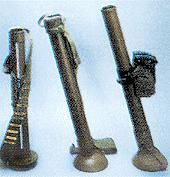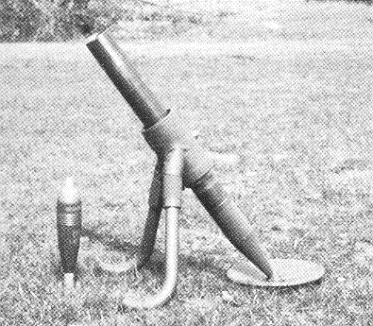UpdateThe US army’s company mortar, the 60mm M224, can be fired without its bipod and baseplate. Only problem with this configuration is the system is still heavier than a commando mortar and the length of the barrel makes it difficult to load if the operator is prone or firing the mortar from the upper decking of a AFV.
Full credit to Mike Sparks of the 1st Tactical Studies Group for the solution. Like many brilliant ideas it is simple and you kick yourself for not thinking of it yourself.
Mike’s idea is to simply cut down the barrels of some of the existing stocks of M224s to create dedicated commando mortars for issue to platoons. His solution avoids all the costly red tape of attempting to procure a new weapon, and also produces a platoon mortar that has the same manual of arms and maintinance routines as the existing 60mm weapons in service.
Commando and Special Operations mortars.
The purpose of this article is twofold.
- Firstly, to familarise readers with the potential of short-barrelled “commando” mortars as platoon-level support weapons.
- Secondly, to suggest a way that a modified design of 60mm mortar could greatly enhance the capabilities of very light forces such as Special Operations Groups.

The South Africans have a very nice 60mm commando mortar, the M4. It has a carrying handle at its centre of gravity that mounts the trigger and a bubble sight. More importantly it can be carried ready loaded. In the event of an ambush the mortar-man simply drops the baseplate to the ground, aims and fires. Unless the mortar-man is one of the first casualties the unit can respond with mortar fire within seconds of being fired upon. While a useful capability for a platoon this is even more desirable for a small special operations unit that is usually out-numbered and doesn't have higher echelon support. South African forces use the term “patmor”, from “patrol mortar”, for commando mortars.
The use of mortars as platoon or squad weapons may not be that familiar to many readers, so I’ll briefly look at some of the better features from past and present models:
- Best known weapon of this type is the Japanese 50mm Model 89 "Knee" mortar. The Japanese infantry or cavalry platoon had up to three such weapons in a mortar squad.
The Model 89 had a mechanism for varying its chamber volume by rotation of a knurled knob. This allowed the user to alter range without changing elevation, a useful feature when firing through a hole in the jungle canopy.
Note how the author remarks how rapidly ambushed Japanese would respond with mortar fire. This is borne out by other contemporary sources.
In addition to using mortar bombs the Model 89 could also fire the Model 91 hand grenade, which conserved ammo during shorter range engagements.
See Here for more information on the Type 89 and Japanese grenades.
It is often not appreciated that because light mortars are trigger or lanyard fired they can be used at very low elevations. The Model 89 was often fired through the firing apertures of enemy blockhouses.
- The current British 51mm mortar is a simpler but slightly heavier weapon than the Model 89. Originally this weapon used a “short range insert (SRI)” that increased chamber volume so the minimum range is reduced from 150m to 50m. The SRI became unnecessary with the adoption of ammo with two charges. For short range fire the secondary charge is easily removed.
- The Belgium Fly-K mortar makes uses of a captive piston system that results in very little firing noise or flash. The French TN-8111 is the current version and several other countries produce versions. The Fly-K is a spigot mortar but it is possible a similar round could be made for conventional 60mm mortars too.
- Certain Brandt models of commando mortars have a small bipod with "J" shaped legs. Elevation is changed by sliding the collar up or down the barrel. Such a device would be useful when in a defensive position since it allows the weapon to be kept aimed at a set range. An alternate system used on the Turkish MKEK Commando mortar has a pair of bipod legs that are pivoted directly from the baseplate.
- Some mortars have range markings on their carrying slings. The foot is placed on the correct marker and the muzzle raised till the sling is taunt, giving the correct elevation.
- The Chinese Type 63 60mm mortar has its bipod and baseplate connected to the barrel by hinges. Using the carrying handle a single soldier can move the entire weapon. This feature was exploited by the Vietnamese for “shoot and scoot” operations.
Although a 60mm commando mortar can use the same ammunition as company-level weapons like the M224 it has a distinct tactical role. Maximum range of these weapons is approximately 700-1100m, making them an idea compliment to 7.62mm machine guns. Platoon mortars can be used to drop bombs on enemies pinned down by MG fire. Mortar fire can also be used to drive enemies from cover to create targeting opportunities for machine gunners. Minimum range can be as little as 50 metres and commando mortars can be fired from a prone position, allowing the firer to directly observe the target. The platoon mortar also gives the platoon an organic capability for large scale illumination or smoke screening. Such a capability can still be used even if support from or communication with higher echelon units is not possible.
All this capability is given by a weapon that can be carried by a single infantryman.
From the above brief descriptions it can be seen that the commando mortar has considerable potential as a platoon support weapon. The following idea intends to expand this even further.
Special Operations Mortar.
The US Army company mortar can be though of as a standard mortar that it is possible to use as a commando. My idea is to instead have a commando mortar that can be converted into a long-range 60mm mortar along the lines of the South African M6. The M6 is currently replacing the 81mm mortar in South African service. The specially developed 2.2kg long-range bomb is claimed to have similar destructive effects to a 81mm and a somewhat greater range (6,000m). The total weapon system is also lighter and logistics are simplified since the same rounds can be used at platoon, company and battalion level.

A weapon that serves as either a commando or long-range weapon would be intended for use by units that have to carry a lot of other equipment or supplies. Like some 81mm mortars the barrel would be in two sections, the lower section with a barrel length of about 740mm.
When on the move the mortar is carried in commando configuration to provide much needed fire support if attacked.
For long range firing the weapon can also be fitted with a baseplate, M252 style bipod and the barrel extension to convert the weapon into a long-range 60mm mortar along the lines of the M6. In this mode the assembled weapon can still be carried by one man for "shoot and scoot" operations.
The weapon can be used by special forces for stand-off attacks on targets such as supply dumps or airfields. A range of specialised ammo can be developed for this role:-
These may include hollow charge-incendiary, thermite, thermobaric or pyrogel.
A hardened cap could be fitted with to the noses of bombs so that they can punch through barriers such as roofing slates or the tops of soft-skin vehicles before detonation. Alternately a long, arrow-like bomb could be developed for better penetration. (Arrow shaped anti-concrete rounds may also be useful in larger mortars). Slower burning propellant charges will also utilise the greater potential that a longer barrel offers.
Another possibility is rounds that are designed to guide in strike aircraft. These may be radio homing beacons or time delayed flares that will attract IR and Electro-optically guided munitions.
Ref.
FEEDBACK
Sv writes:The USA is developing a laser seeker for 70mm Hydra rockets (AKPWS) and even smaller laser receivers exist on the darts of the Starstreak missile
Couple such a laser seeker with a French or South African 60mm long-barreled rifled mortar and a jamming-resistant optical proximity fuse or contact fuse, and you have a really deadly commando weapon. -6km range, high precision, low noise, low weight, high ammunition weight efficiency.
Vehicle mounts for Commando mortars.
During WW2 most Bren gun/Universal carriers carried a 2" platoon mortar in addition to their bren guns.
My suggestion that 60mm commando mortars be introduced into platoons has been well received. Obviously such weapons can be fired from a vehicle such as a M113. One way to do this is just to rest the base of the mortar on the roof but it would be nice if the weapon could be kept trained at preset firing co-ordinates. If a sliding bipod is fitted this would only require some way to secure the butt. A more elaborate mounting would be a turn-table onto which the mortar attaches. One handgrip makes fine adjustments to traverse, the other handles elevation and has a trigger.
Following the first publication of this article there has also been interest in the idea of launching grenades from mortars. A rifle-hand grenade as described could easily be adapted to mortar launch by fitting it with a 60mm disc mounting a propellant charge. I doubt such projectiles would have sufficient range for company fire support missions, but for platoon support (in commando mortars) their use would conserve mortar bombs for longer range fire. Grenades adapted to mortar fire would be lighter than bombs, so less of a burden to the unit.









